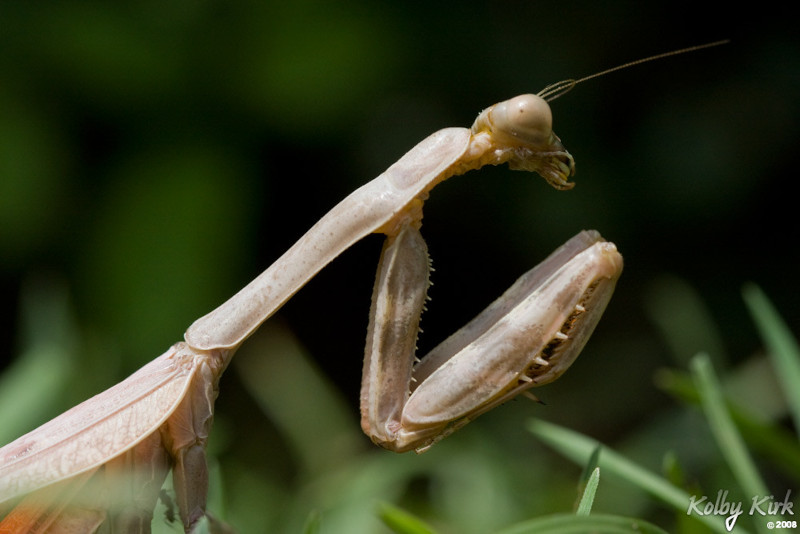
California Mantis Facts
- This remarkable Arthropod most frequently goes by the descriptive and informative common name of the California Mantis. For the moment, it has no other broadly accepted general title. Though certainly not unknown, that’s somewhat uncommon.
- Within the scientific community, however, it’s possibly better known by its technical moniker. That term, though, is somewhat difficult for most laypeople to pronounce. That’s because this natural wonder holds the epithet Stagmomantis californica.
- The impressive invertebrate received that designation due to the efforts of the duo of James Abram Garfield Rehn and Morgan Hebard. The noted American entomologists accomplished the first recognition of it as a separate and distinct species in 1909.
- The amazing California Mantis appears to be maintaining a population base that’s both stable and sufficient. That pleasant state also seems to hold true throughout its entire range. The IUCN therefore does not presently show it on its published Red List.
- The biological marvel nevertheless still faces multiple potential threats to its existence as a species. Like all other forms of life on earth today, most of these stem from the actions of man. They include such perils as habitat loss and ongoing climate change.
Related Articles
California Mantis Physical Description
The intriguing California Mantis captures the attention of most of those who encounter it, like most of its relatives around the world. It does not do so due to impressive size, however. That’s because this lovely biological masterpiece is an average-sized species of mantis.
It also follows a well-established pattern common among its kindred. That’s in the fact that it displays a certain amount of the physiological characteristic of sexual dimorphism. In the case of this creature, that natural trait manifests in both structure and general appearance.
Collectively, the two genders attain average body lengths of between 2 – 3 in (5.1 – 7.6 cm). Males, though, possess a total of eight abdomenal segments. The females, meanwhile, only have six of these. Females thus tend to be slightly shorter than the males.
The fascinating Arthropod displays further gender-based physical variations, as well. Among females, the hindwings develop as either a deep purple or dark brown in color. These features also generally have either a light reddish-brown or orange-yellow base.
Males of the California Mantis, however, present a different pattern. For them, the forewings show an almost translucent coloring. These do, though, have narrow, lightly-colored marginal strips. Yet, the hindwings show a dark brown, with a mottle pattern.
The body itself, though usually covered by the wings, presents a chocolate to light brown hue. The inner forelegs show an orange shade, while a scattering of small black spots appear near the mandibles. The sharply oval face also holds two outsized compound eyes.
- Kingdom: Animalia
- Phylum: Arthropoda
- Class: Insecta
- Order: Mantodea
- Family: Mantidae
- Genus: Stagmomantis
- Species: S. californica
California Mantis Distribution, Habitat, and Ecology
The gorgeous California Mantis evolved as endemic to a moderately broad expanse of the surface of the earth. The precise location of that zone of habitation might surprise you, however. It does appear inside of North America, yes, but the name’s somewhat deceptive.
It’s found almost exclusively within the national borders of the United States. To the far south, though, a small population also lives in northern Mexico. Concentrated in southern California, its territory extends from there eastward as far as western sections of Texas.
Like many related invertebrates scattered across the globe, this product of specialized evolution displays decidedly strong preferences regarding its choice of habitat type. For starters, it’s virtually never seen at altitudes great than 10,000 ft (3,048 m) above sea level.
Inside of that restriction, however, it shows further favoritism. It prefers areas that are both drier and warmer. The favorite location for the mantis appears to be desert environments and regions of chaparral. Areas with creosote bushes enhance this even further.
Like all mantids, the stuning California Mantis developed as a powerful, carnivorous, predator. It’s also indiscriminate in its prey. The insect eats virtually any other invertebrate small enough to be eaten. Amazingly, this even extends to members of its own species.
It additionally lives a primarily solitary life. The sexes typically only come together for mating purposes. Mating and reproduction takes place in Autumn, with eggs hatching in early spring. A typical lifespan equals about nine months, and rarely more than a full year.
Species Sharing Its Range
Check out our other articles on 5 Beautiful Black Sea Species, Eastern Gray Squirrel, Tatra Mountains, Coral Honeysuckle, Indian Vulture, Black Rain Frog, Alligator Snapping Turtle, Bird Cherry
